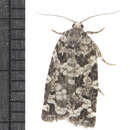Conservation Status
provided by University of Alberta Museums
Widespread and of no concern.
- license
- cc-by-nc
- copyright
- University of Alberta Museums
Cyclicity
provided by University of Alberta Museums
Late June to the end of July.
- license
- cc-by-nc
- copyright
- University of Alberta Museums
Distribution
provided by University of Alberta Museums
Across the boreal from British Columbia to Newfoundland, south to Maine, New Hampshire, and Wyoming.
- license
- cc-by-nc
- copyright
- University of Alberta Museums
General Description
provided by University of Alberta Museums
"This species is slightly smaller than the similar A. dissitana and has dirtier looking markings. The forewing is light grey speckled or reticulated with darker grey and with dark grey full or partial bands in the basal, median, postmedian and subterminal areas. The hindwings are dark grey with a white costal margin. This species can be separated from the very rarely collected Archepandemis coniferana by the pattern of pale markings on the forewing. In A. coniferana, the middle pale costal spot is roughly continuous with the white band that extends down towards the anal angle, while in A. packardiana, these two markings are clearly disjunctive from each other.
The larva is green with short fine setae throughout. The head is darker greenish with darker black lines and the thoracic shield is green, variably blackish brown anterioirly."
- license
- cc-by-nc
- copyright
- University of Alberta Museums
Habitat
provided by University of Alberta Museums
Widespread in the boreal forest and anywhere spruce or fir are found.
- license
- cc-by-nc
- copyright
- University of Alberta Museums
Life Cycle
provided by University of Alberta Museums
The first instar larva mines needles and overwinters there. In the spring it continues to mine needles and in later instars it feeds externally on needles, spinning abundant silk . Pupation is done amongst the webbed needles. Adults frequnt lights and females oviposit on the foliage. (Duncan 2006)
- license
- cc-by-nc
- copyright
- University of Alberta Museums
Trophic Strategy
provided by University of Alberta Museums
White Spruce (Picea glauca), Engelmann Spruce (Picea engelmanni), Black Spruce (Picea mariana), Balsam Fir (Abies balsamea) (Duncan 2006).
- license
- cc-by-nc
- copyright
- University of Alberta Museums
Archips packardianus
provided by wikipedia EN
Archips packardianus, the spring spruce needle moth or spruce needleworm, is a species of moth of the family Tortricidae. Spruce needle worms are commonly found in small numbers on spruce and trees of other coniferous genera throughout most of Canada and the northeastern US (Rose and Lindquist 1985).[2] Archips packardiana overwinters as a tiny larva in a mined needle. Needle mining is resumed in the spring, the larvae later moving to feed on new foliage, where they spin considerable webbing. Full-grown larvae have a pale green head, sometimes patterned with brown, and a pale body and pale thoracic legs, and are about 20 mm long. The larva pupates, usually in the webbed needles, and the adult emerges in summer to early fall. The closely related Archips strianus is much less common, but probably has a habitat similar to that of A. packardiana (Rose and Lindquist 1985).[2] The larvae have dark thoracic legs and small dark areas around the base of the thoracic hairs. The habitat consists of coniferous and mixed woods.
The wingspan is about 17 mm. There is a pattern of black and white patches on the forewings. The hindwings are dark grey.[3] Adults have been recorded on wing in April and from June to October.
The larvae feed on the needles of Picea and Abies species.
References
-
^ tortricidae.com
-
^ a b Rose, A.H.; Lindquist, O.H. 1985. Insects of eastern spruces, fir and, hemlock, revised edition. Gov’t Can., Can. For. Serv., Ottawa, For. Tech. Rep. 23. 159 p. (cited in Coates et al. 1994, cited orig ed 1977)
-
^ Bug Guide

- license
- cc-by-sa-3.0
- copyright
- Wikipedia authors and editors
Archips packardianus: Brief Summary
provided by wikipedia EN
Archips packardianus, the spring spruce needle moth or spruce needleworm, is a species of moth of the family Tortricidae. Spruce needle worms are commonly found in small numbers on spruce and trees of other coniferous genera throughout most of Canada and the northeastern US (Rose and Lindquist 1985). Archips packardiana overwinters as a tiny larva in a mined needle. Needle mining is resumed in the spring, the larvae later moving to feed on new foliage, where they spin considerable webbing. Full-grown larvae have a pale green head, sometimes patterned with brown, and a pale body and pale thoracic legs, and are about 20 mm long. The larva pupates, usually in the webbed needles, and the adult emerges in summer to early fall. The closely related Archips strianus is much less common, but probably has a habitat similar to that of A. packardiana (Rose and Lindquist 1985). The larvae have dark thoracic legs and small dark areas around the base of the thoracic hairs. The habitat consists of coniferous and mixed woods.
The wingspan is about 17 mm. There is a pattern of black and white patches on the forewings. The hindwings are dark grey. Adults have been recorded on wing in April and from June to October.
The larvae feed on the needles of Picea and Abies species.
- license
- cc-by-sa-3.0
- copyright
- Wikipedia authors and editors

